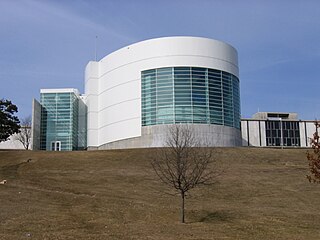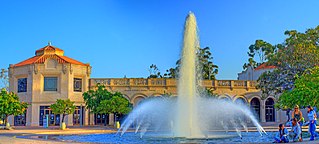
The Mugar Omni Theater is a domed IMAX theater at the Museum of Science, in Boston, Massachusetts. [1]

The Mugar Omni Theater is a domed IMAX theater at the Museum of Science, in Boston, Massachusetts. [1]
The Mugar Omni is named after Stephen P. Mugar, the founder of Star Market, and his wife Marian G. Mugar. The Mugar Omni is non-profit and opened in 1987. [2] Over 900,000 visitors came in its first year. [3] It is the only domed IMAX theater in New England and is one of only 60 IMAX Theaters in the world to offer 180 degree domed viewing. The seats are set at a steep (cliff-side) angle and recline about thirty degrees, the screen is five stories tall, and the theater is filled with an impressive surround sound system. Because the screen fills a viewer's field of vision (including periphery vision) the screen and surround sound system give viewers the feeling of immersion and motion giving visitors a unique life like experience when viewing films. Viewers must turn their heads left to right up and down to capture all that is going on. [4] The theater shows films of educational and scientific interest such as: Bears, Beavers, Amazing Caves, Shackleton's Antarctic Adventure as well as select IMAX feature film releases in 1.43:1 aspect ratio. [5] [6] Leonard Nimoy was a host of the opening of the theater.
The average 70mm Omnimax film reel is around 3 miles long, weighs 200 pounds, and needs to be configured manually.

70 mm film is a wide high-resolution film gauge for motion picture photography, with a negative area nearly 3.5 times as large as the standard 35 mm motion picture film format. As used in cameras, the film is 65 mm (2.6 in) wide. For projection, the original 65 mm film is printed on 70 mm (2.8 in) film. The additional 5 mm contains the four magnetic stripes, holding six tracks of stereophonic sound. Although later 70 mm prints use digital sound encoding, the vast majority of existing and surviving 70 mm prints pre-date this technology.

To Fly! is a 1976 American short docudrama film directed by Greg MacGillivray and Jim Freeman of MacGillivray Freeman Films, who wrote the story with Francis Thompson, Robert M. Young, and Arthur Zegart. It premiered at the giant-screen IMAX theater of the National Air and Space Museum, which opened to celebrate the United States Bicentennial. The film chronicles the history of aviation in the US, with a narration written by Thomas McGrath. Thematically, it explores the search for national identity through the country's westward expansion as well as humanity's relationship with aviation.

A movie theater, cinema, or cinema hall, also known as a movie house, picture house, picture theater or simply theater, is a business that contains auditoria for viewing films for public entertainment. Most are commercial operations catering to the general public, who attend by purchasing tickets.

IMAX is a proprietary system of high-resolution cameras, film formats, film projectors, and theaters known for having very large screens with a tall aspect ratio and steep stadium seating, with the 1.43:1 ratio format being available only in few selected locations.

The National Science and Media Museum, located in Bradford, West Yorkshire, is part of the national Science Museum Group in the UK. The museum has seven floors of galleries with permanent exhibitions focusing on photography, television, animation, videogaming, the Internet and the scientific principles behind light and colour. It also hosts temporary exhibitions and maintains a collection of 3.5 million pieces in its research facility.

Cinerama is a widescreen process that originally projected images simultaneously from three synchronized 35mm projectors onto a huge, deeply curved screen, subtending 146-degrees of arc. Subtending refers to the pathways of the projected images from the synchronized projectors onto the curved screen overlapping each other at one point. The trademarked process was marketed by the Cinerama corporation. It was the first of several novel processes introduced during the 1950s when the movie industry was reacting to competition from television. Cinerama was presented to the public as a theatrical event, with reserved seating and printed programs, and audience members often dressed in their best attire for the evening.
3D films are motion pictures made to give an illusion of three-dimensional solidity, usually with the help of special glasses worn by viewers. They have existed in some form since 1915, but had been largely relegated to a niche in the motion picture industry because of the costly hardware and processes required to produce and display a 3D film, and the lack of a standardized format for all segments of the entertainment business. Nonetheless, 3D films were prominently featured in the 1950s in American cinema, and later experienced a worldwide resurgence in the 1980s and 1990s driven by IMAX high-end theaters and Disney-themed venues. 3D films became increasingly successful throughout the 2000s, peaking with the success of 3D presentations of Avatar in December 2009, after which 3D films again decreased in popularity. Certain directors have also taken more experimental approaches to 3D filmmaking, most notably celebrated auteur Jean-Luc Godard in his film Goodbye to Language.

A movie projector is an opto-mechanical device for displaying motion picture film by projecting it onto a screen. Most of the optical and mechanical elements, except for the illumination and sound devices, are present in movie cameras. Modern movie projectors are specially built video projectors.

The Museum of Science (MoS) is a nature and science museum and indoor zoological establishment located in Science Park, a plot of land in Boston and Cambridge, Massachusetts, spanning the Charles River. Along with over 700 interactive exhibits, the museum features a number of live and interactive presentations throughout the building each day, along with scheduled film showings at the Charles Hayden Planetarium and the Mugar Omni Theater. Additionally, the Museum of Science is an accredited member of the Association of Zoos and Aquariums (AZA), being home to over 100 animals, many of which the museum gained after they were surrendered, confiscated, rescued or rehabilitated.

The Science Museum of Minnesota is an American museum focused on topics in technology, natural history, physical science, and mathematics education. Founded in 1907 and located in Saint Paul, Minnesota, the 501(c)(3) nonprofit institution has 385 employees and is supported by volunteers.

The Putnam Museum and Science Center, formerly Davenport Academy of Natural Sciences, is a museum of history and natural science and a science center in Davenport, Iowa, United States. The museum was founded in 1867, and was one of the first museums west of the Mississippi River. It houses 160,000 historical artifacts and specimens and a giant screen theater. It is located at 1717 West 12th Street, at the corner of Division and West 12th Street on "museum hill," near Fejervary Park. It is an affiliate of the Smithsonian Institution.
Fort Worth Flyover is the name of a short IMAX film created for the Omni Theater at the Fort Worth Museum of Science and History, the first one commissioned by a specific museum. Designed to simulate flying over Fort Worth, Texas in a helicopter, the movie is traditionally shown before each Omni Theater feature, in part to acclimatize new viewers to the IMAX format.

The Fleet Science Center is a science museum and planetarium in Balboa Park, located in San Diego, California. It is at the east end of the El Prado Drive walkway, next to the Bea Evenson Fountain and plaza in central Balboa Park.

Telus World of Science Edmonton (TWOSE) is a broad-based science centre in Edmonton, Alberta, Canada, operated by the (non-profit) Edmonton Space & Science Foundation. The centre is located on the southwest corner of Coronation Park in the neighborhood of Woodcroft. The science centre houses 144,430 sq. ft. of public space and is the largest science centre in Western Canada. It is currently a member of both the Association of Science-Technology Centers (ASTC) and the Canadian Association of Science Centres (CASC).
Super Panavision 70 is the marketing brand name used to identify movies photographed with Panavision 70 mm spherical optics between 1959 and 1983. It has since been replaced by Panavision System 65.

The Milton J. Rubenstein Museum of Science and Technology is a science and technology museum located in the Armory Square neighborhood of Downtown Syracuse, New York. The Museum includes 35,000 square feet of permanent and traveling exhibits, Science Shop, and several programs and events. The MOST is located in the former Syracuse Armory.

The Omni-Theatre is an observatory and large-format film theatre located at the Science Centre Singapore in Jurong East, Singapore.
Smithsonian Theaters is an operating unit of Smithsonian Enterprises, the revenue-generating business division for the Smithsonian Institution, United States.

The Virginia Air and Space Science Center is a museum and educational facility in Hampton, Virginia that also serves as the visitors center for NASA's Langley Research Center and Langley Air Force Base. The museum also features an IMAX digital theater and offers summer aeronautic- and space-themed camps for children.

Dolby Cinema is a premium cinema created by Dolby Laboratories that combines Dolby proprietary technologies such as Dolby Vision and Dolby Atmos, as well as other signature entrance and intrinsic design features. The technology competes with IMAX and other premium large formats such as Cinemark XD and Regal's RPX.